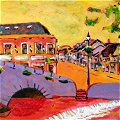Goat Burning Season Is Upon Us
Why would you want to burn a goat? I do. I want to burn the Gävle Goat.
Why?
The burning of a great log during the winter solstice is an ancient custom that many believe began with the Norsemen, and was carried over to the Christian celebration of Christmas. The word yule is thought to derive from the Norse word hweol, which means wheel and refers to the great wheel of the sun in its yearly cycle. But a Goat? Bear with me. I’ll even show you a webcam.
Yule Log
The Yule log was usually a whole tree trunk or part of the root of a large oak or ash tree. It had to be big enough to burn for the Twelve Days of Christmas and still have a small piece left over with which to kindle the following year’s log. An old Norse belief was that each spark from the Yule log represented a new chicken, pig, lamb, goat, or calf to be born in the coming year. See, we’re at least talking goats now.
Yule Tree
Eventually, the tradition of the burning of the Yule log was replaced with the Yule Tree. Decorating the tree was a custom introduced from Germany into Scandinavia during the nineteenth century. Initially the tree was decorated with burning candles. And most ancient references to Yule trees had them upside down. You might not want to try this at home despite the obvious aesthetic improvement.
Decorating the Christmas Tree
Naturally elctricity came in and the candles went out. And on Christmas Eve, parents in Swedish families decorate the Christmas tree behind closed doors as a surprise for the children. Decorations are usually simple; the most popular are straw goats and pigs. So now we have goats of straw. But why you ask? And is it art?
Yule Goat
Well the “Julbukk” (Yule goat) used to be the carrier of the God Thor (or Thunor). Now the Yule goat is older and carries the elf - who is much lighter than the God of Thunder. But the Elf does have the presents with him for delivering. This Yule elf is called Jultomten in Sweden, Julesvenn in Norway, and Jule-nissen in Denmark and Norway. An offering of porridge, or rice and milk, or Ready Brek if you’re in a hurry, is left for the Yule elf on the eve of Yule (or Christmas).
Straw Goat
Anyway, it gets a little complicated as the goat is also a symbol of satan as the escort of St. Nikolaus, the patron saint of children. But what it means is that today, the goat is a prominent symbol for Christmas in Sweden, where a goat of straw often can be found under the Christmas tree, and basically anywhere else.
The Rabbit Of Easter and other odd customs
Now if you come from a place which celebrates Christmas but does not use a goat to do so, well do not snigger. We can all be David Sedaris and find an Easter Bell flying in from Rome to France a lot less appropriate than the Rabbit of Easter for delivering chocolate secretly to your home in the midle of the night, but aren’t you already using a Christmas Tree? And you got your Christmas Tree from the same people that you haven’t got your goat from - yet. Even if you only have it for the 12 hours of Christmas instead of the 12 Days? It literally is a matter of time before it becomes the 12 Minutes of Christmas. And how exactly does Santa get into your house anyway, with you living in a smoke-free zone and all? People with straw myths shouldn’t throw burning arrows.
Gävle Builds the Goat
Which takes us to 1966. Yes it does. That’s when the town of Gävle in Sweden has erected a huge goat of straw every year since. Wikipedia has a full entry on it, and its fame is worldwide because of what happens to the Goat more often than not.
Gävle Destroys the Goat
Not planned by the goat builders, be they merchants, city authorities, or scientists. And an act of vandalism that really is illegal, but there is a tradition of destroying the goat. It’s nice to think it’s burned ceremoniously on Christmas Eve - but it isn’t. Certainly it has been burned many many times, but it has also had a car crash into it, and had its legs destroyed, among other fatalities. And it can happen from the moment it is erected.
An American Destroys the Goat
Since the first giant goat was erected in the town in 1966, only seven have survived Christmas. During that time only one person has been caught and found guilty of arson: an American tourist who claimed in court that he thought he was taking part in a completely legal goat-burning tradition.
It burned again the year before last. Despite the security cameras, despite the fireproofing, despite the police watch, the Goat burned down the year before last.
Santa Destroys the Goat
According to The Local in Sweden, a Santa and a Gingerbread Man were suspected of burning down the famous Christmas Goat in Gävle. Police suspected them of using either a flaming arrow or a flare.
An Indestructible Goat?
In a world where a Burning Man is art, and so is a Wicker Man especially when he burns, and where we toss cows or shoot at hanging clay pots with cats in them, what do we expect of large straw animals? You could make a structure to look like it is made of straw but really be of metal - like the Horses of ‘driftwood’ at Kansas City, Missouri’s Zoo - but why?
Last year the goat survived its attackers.
Update: But for Christmas 2008 it didn’t survive
Tradition as Art
If you did that then you would lose the tradition of the build, and of the hunt, and the ultimate - or not if the security forces win, much like the German wooden pieces in the board game Colditz - destruction. And so the Burning Goat of Gavle in Sweden is very much art, a celebration, of construction and possible destruction, and life just going on.
See the Goat
The official website for the town of Gavle in Sweden is www.gavle.se, where there is also a webcam with live pictures of what state the goat is in now. If you wish to see the goat in flames, with all its current protection and prevention then you may have missed your chance - though I hope not. It’s an impressive sight.

 Eolaí gan Fhéile:
Eolaí gan Fhéile:










